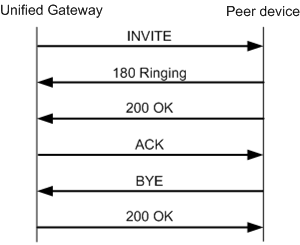Navigation: Fault Management > Troubleshooting Guide > Trunk Faults > Background >
This topic describes the basic concept and signaling process for the SIP trunk.
Basic Concept
Session Initiation Protocol (SIP) is a signaling control protocol at the application layer and is used to create, modify, and terminate two-party or multi-party sessions. Session Description Protocol (SDP) is used to describe multimedia communication sessions for session announcement and invitation, and multimedia session initialization.
Signaling Process
Figure 1 shows the normal signaling process.
Figure 1 Normal signaling process

The normal signaling process is as follows:
1.When an intra-office user attempts to call an peer user, unified gateway sends an INVITE message to set up a call.
2.Peer device sends a 180 Ringing message indicating that the peer user's phone is ringing.
3.Peer device sends a 200 OK message indicating that the peer user has picked up the phone.
4.unified gateway sends an ACK message indicating that the intra-office user is talking with the peer user.
5.Peer device sends a BYE message indicating that the peer user has hung up.
6.unified gateway sends a 200 OK message indicating that the intra-office user has been informed that the office user B has hung up. The intra-office user then hangs up.
Parent Topic: Background